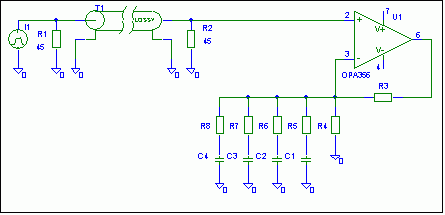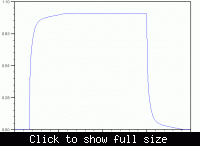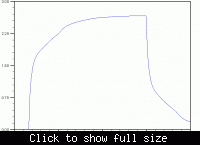PaloAlto
Full Member level 4

- Joined
- Oct 8, 2007
- Messages
- 194
- Helped
- 35
- Reputation
- 70
- Reaction score
- 10
- Trophy points
- 1,298
- Location
- Cádiz, Spain
- Activity points
- 2,506
lossy cable
Hi all,
I need to transfer a 40MHz square wave through a lossy cable. The RLGC model of the cable is R=6.0ohm/m. L=243nH/m. G=1u. C=120pF/m. The max length is 5m. The signal itself is in fact not a digital signal. Instead is half cycle a reference value and the other half any data (so, it is an analog signal).
I've been working on it for a few days already. I am having problems with a very degraded signal and I am still not sure whether it is bad matching or just attenuation.
I have simulated the Zo of the cable over freq and the real part changes from 2.4K in LF to 45 ohm in HF. The imaginary part goes from 0 to 0, but in the middle frequencies it gets as high as 800.
I have a few fundamental questions:
* What is the bandwidth of a square signal? Does it have freq components below 20MHz? If so they would not be matched properly (?)
* Is the attenuation the same for the signal whether it is voltage or current?
* Is it possible to create a matching network for the entire frequency band. For instance, a 1rst order approach is a parallel R of 2.4K, then a series cap, and another parallel R of 45. But this doesn't match for the high X in mid freqs.
I would appreciate any help
Thanks
Hi all,
I need to transfer a 40MHz square wave through a lossy cable. The RLGC model of the cable is R=6.0ohm/m. L=243nH/m. G=1u. C=120pF/m. The max length is 5m. The signal itself is in fact not a digital signal. Instead is half cycle a reference value and the other half any data (so, it is an analog signal).
I've been working on it for a few days already. I am having problems with a very degraded signal and I am still not sure whether it is bad matching or just attenuation.
I have simulated the Zo of the cable over freq and the real part changes from 2.4K in LF to 45 ohm in HF. The imaginary part goes from 0 to 0, but in the middle frequencies it gets as high as 800.
I have a few fundamental questions:
* What is the bandwidth of a square signal? Does it have freq components below 20MHz? If so they would not be matched properly (?)
* Is the attenuation the same for the signal whether it is voltage or current?
* Is it possible to create a matching network for the entire frequency band. For instance, a 1rst order approach is a parallel R of 2.4K, then a series cap, and another parallel R of 45. But this doesn't match for the high X in mid freqs.
I would appreciate any help
Thanks






